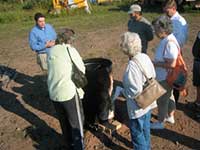Sep 22 2008
There’s a new player on the organic gardening front. It's called biochar, and it could be good medicine for the planet as well as for crops, because it can help mitigate global warming by sequestering carbon that would otherwise be released into the atmosphere.
 Students and community gardeners watch as wood scraps are turned into biochar. Michigan Technological University
Students and community gardeners watch as wood scraps are turned into biochar. Michigan Technological University
Amazon natives have used it for centuries to improve their soil and grow better crops. Now it’s being made by Michigan Technological University students on the Upper Peninsula of Michigan.
The product of a slow-burning charcoal-creation process, biochar can vastly improve soils for growing food and other plants.
How vast?
"Eight-hundred and eighty percent," says Michigan Tech faculty member Michael Moore "We didn't believe it either, so we kept investigating, and soil with biochar and fertilizer indeed was 880 percent more productive than soil with only fertilizer."
Studies have shown that, when mixed into the soil, the charcoal acts as a sponge, holding water and promoting growth of beneficial microbes, and it can stay in the soil for hundreds or even thousands of years.
To test the process, Moore’s class tried both vertical and horizontal placement of a 55-gallon barrel containing the fire. They discovered that the horizontal drum allowed for better burning.
"We burned sticks, twigs and even pallets," says Gary Franz, an industrial technology senior. "We got it going and then slowly covered it. After a four-to-five-hour burn, we let it sit for a day.” The result was lightweight charcoal chunks that can be tilled into soil.
Leaves, branches and yard trimmings, sawdust and wood chips can be used to produce biochar. “You can burn nearly anything carbon-based and formerly living," Franz says.
Doesn’t burning add to the problem of greenhouse gases?
"Because of the nature of the burn, the carbon released is less," says Dane Heimerman, a fifth-year mechanical engineering major. "Fifty percent of the carbon is released, compared to 80 percent in normal burning, and some burn processes actually capture the gases and put them back into the fire. Most importantly, when the charcoal is returned to the ground, it is actually carbon negative."
The seven-week course is part of a science and society curriculum. “We acknowledge that we are not scientists," says Michelle McCoy, a third-year scientific and technical communications major. "But we wanted to approach this from a community aspect, getting the word out about this process, which has great potential."
The students are encouraging their neighbors to try biochar. They’re considering using it in community gardens, promoting the idea at the upcoming county fair and assessing the feasability of a community biochar project.
For more information go to http://composing.org/hu2506summer/.